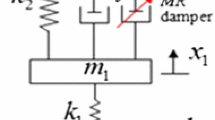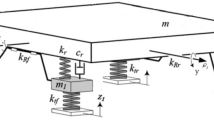Abstract
Traffic accidents are often caused by vibration of automotive steering because the vibration can make a vehicle run like a snake. A novel semi-active vibration control strategy of automotive steering with magneto-rheological (MR) damper is proposed in this paper. An adaptive RBF neural sliding mode controller is designed for the vibration system. It is showed that an equivalent dynamic model for the vibration system is established by using Lagrange method, and then treats it as actual system partially. A feedback control law is designed to make this nominal model stable. Uncertain part of system and outside disturbance are estimated using RBF neural network, and their upper boundary is obtained automatically. By constructing reasonable switch function, state variables can arrive at origin asymptotically along the sliding mode. Strong robust character of control system is proved by stability analysis and a numerical simulation example is performed to support this control scheme.










Similar content being viewed by others
References
Jocelyn I An overview of landing gear dynamics. NASA/TM–1999-209143
Kim M-G, Jeong H-I Sensitivity analysis of chassis system to improve shimmy and brake judder vibration on steering wheel. SAE 960743
Pacejka HB (1996) The wheel shimmy phenomenon. Ph.D. Thesis, Delft University of Technology
Somieski G (1997) Shimmy analysis of a simple aircraft noise landing gear model using different mathematical methods. Aerosp Sci Technol 8:545–555
Somieski G (2001) An eigenvalue method for calculation of stability and limit cycles in nonlinear systems. Nonlinear Dyn 26:3–22
Zhou JX, Zhang L (2005) Incremental harmonic balance method for predicting amplitudes of a multi-D.O.F. nonlinear wheel shimmy system with combined coulomb and quadratic damping. J Sound Vib 279:403–416
Kovacs AP (1998) Computational vibration analysis of vehicle shimmy by a power-work method. Veh Syst Dyn 29:341–364
Lin Y, Li S (2004) Study on the bifurcation character of steering wheel self-excited shimmy of motor vehicle with dependent suspension. Chin J Mech Eng 40(12):187–191
Zhang Q, Chen Y (1995) Studying the stability and bifurcation character of automobile shimmy. J Tianjin Univ 28(3):409–414
Brandt ME, Chen G (1997) Bifurcation control of two nonlinear modals of cardiac activity. IEEE Trans Circuits Syst 44:1031–1043
Gu G, Chen X, Sparks AG et al. (1999) Bifurcation stabilization with local out feedback. SIAM J Control Optim 37:934–956
Wang HO, Chen D, Chen G (1998) Bifurcation control of pathological heart rhythms. In: Proceedings of IEEE conference on control application, Trieste, Italy
Basso M, Evangelisti A, Genesio R, Test A (1998) On bifurcation control in time delay feedback systems. Int J Bifurc Chaos 8:713–721
Chen G, Moiola JL, Wang HO (2000) Controlling bifurcations: theories, methods and applications. Int J Bifurc Chaos 10(3):511–548
Spencer BF Jr, Dyke SJ, Sain MK et al. (1997) Phenomenological model for magneto-rheological dampers. J Eng Mech 123(3):230–238
Wereley NM, Pang L, Kamath GM (1998) Idealized hysteresis modeling of electro-rheological and magneto-rheological dampers. J Intell Mater Syst Struct 9(8):642–649
Choi SB, Lee SK, Park YP (2001) A hysteresis model for the field-dependent damping force of a magneto-rheological damper. J Sound Vib 245(2):375–383
Pan G, Matsuhisa H, Honda Y (2000) Analytical model of magneto-rheological damper and its application to the vibration control. In: IEEE international control conference, pp 1850–1855
Li WH, Yao GZ, Yeo SH et al. (2000) Testing and steady state modeling of a nonlinear MR damper under sinusoidal loading. Smart Mater Struct 9:95–102
Schurter KC, Roschke PN (2000) Fuzzy modeling of a magneto-rheological damper using ANFIS. In: Proceedings of the IEEE international conference on fuzzy systems, pp 122–127
Wang D-H, Liao W-H (2001) Neural network modeling and controller for magneto-rheological fluid dampers. In: IEEE international fuzzy system conference, pp 1323–1326
Chang CC, Zhou L (2002) Neural network emulation of inverse dynamics for a magneto-rheological damper. J Struct Eng 128(2):231–239
Sáez D, Cortés CE, Núñez A (2007) Hybrid adaptive predictive control for the multi-vehicle dynamic pick-up and delivery problem based on genetic algorithms and fuzzy clustering. Comput Oper Res 34(1):2–27
Bianchessi N, Righini G (2007) Heuristic algorithms for the vehicle routing problem with simultaneous pick-up and delivery. Comput Oper Res 34(2):578–594
Ying ZG, Zhu WQ, Soong TT (2003) A stochastic optimal semi-active control strategy for ER/MR damper. J Sound Vib 259(1):45–62
Choi SB, Lee HS, Park YP (2002) H ∞ control performance of a full-vehicle suspension featuring magneto-rheological dampers. Veh Syst Dyn 38(5):341–360
Lai CY, Liao WH (2002) Vibration control of a suspension system via a magneto-rheological fluid damper. J Vib Control 8(4):527–547
Du H, Yim Sze K, Lam J (2005) Semi-active H ∞ control of vehicle suspension with magneto-rheological dampers. J Sound Vib 283:981–996
Huang S-J, Chen H-Y (2006) Adaptive sliding controller with self-tuning fuzzy compensation for vehicle suspension control. Mechatronics 16:607–622
Sun L, Cai X, Yang J (2007) Genetic algorithm-based optimum vehicle suspension design using minimum dynamic pavement load as a design criterion. J Sound Vib 301:18–27
Guclu R, Gulez K (2008) Neural network control of seat vibrations of a nonlinear full vehicle model using PMSM. Math Comput Model 47:1356–1371
Chang S-C (2007) Synchronization in a steer-by-wire vehicle dynamic system. Int J Eng Sci 45:628–643
Simionescu PA, Tempea I, Loch NE (2001) Kinematic analysis of a two-degree-of-freedom steering mechanism used in rigid-axle vehicle. Proc Inst Mech Eng, D 215:803–812
Data S, Pesce M, Reccia L (2004) Identification of steering system parameters by experimental measurements proceeding. Proc Inst Mech Eng, D 218:783–792
Du Y, Lion A, Maißer P (2006) Modeling and control of an electromechanical steering system in full vehicle models. Proc Inst Mech Eng, I 220:239–249
Lin FJ, Wai RJ (2001) Hybrid control using recurrent fuzzy neural network for linear-induction motor servo drive. IEEE Trans Fuzzy Syst 9:102–115
Efe MO, Unsal C, Kaynak O et al. (2004) Variable structure control of a class of uncertain systems. Automatica 40:59–64
Lin F, Wai R, Hong C (2001) Identification and control of rotary traveling wave ultrasonic motor using neural networks. IEEE Trans Control Syst Technol 9(4):672–680
Huang JQ, Lewis FL (2003) Neural-network predictive control for nonlinear dynamic system with time-delay. IEEE Trans Neural Netw 14:377–389
Yau H-T, Yan J-J (2009) Adaptive sliding mode control of a high precision ball-screw-driven stage. Nonlinear Anal, Real World Appl 10:1480–1489
Chen PC, Chen CW, Chiang WL (2009) GA-based modified adaptive fuzzy sliding mode controller for nonlinear systems. Expert Syst Appl 36:5872–5883
Author information
Authors and Affiliations
Corresponding author
Additional information
Support by Doctor Fund 2010BSJJ016 and Basic Scientific Research Cost QN2011141 of Northwest A & F University.
Appendix: Coefficients expression in Eq. (7) and main simulation parameters of nominal model
Appendix: Coefficients expression in Eq. (7) and main simulation parameters of nominal model
Coefficients of Eq. (7) are written as bellow

Main simulation parameters of nominal model used by numerical analysis are given as follows J 1=J 2=15(kg m2/rad), J 3=6 (kg m2/rad), J 4=12 (kg m2/rad), c 1=c 2=50 (N m s/rad), c 3=20 (N m s/rad), c 4=60 (N m s/rad), k 1=k 2=5e004 (N m/rad), k 3=6e004 (Nm/rad), k 4=7e004 (N m/rad), \(c'_{1} = c'_{2} = 20\allowbreak (\mbox{N}\,\mbox{m}\,\mbox{s}/\mbox{rad})\), \(c'_{3} = c'_{4} = 10\ (\mbox{N}\,\mbox{m}\,\mbox{s}/\mbox{rad})\), m 1=m 2=12(kg), τ=0.03 (rad), μ=0.015, r w =0.35 (m), k ⊥=1.2e006 (N/m), L=0.15 (m), ρ=1.5e005 (N/m), k=9e004 (N/rad), D x1=D x2=0.06 (m), k α =1.4149, k β =0.0347.
Rights and permissions
About this article
Cite this article
Wang, W., Song, Y. Nonlinear vibration semi-active control of automotive steering using magneto-rheological damper. Meccanica 47, 2027–2039 (2012). https://doi.org/10.1007/s11012-012-9572-z
Received:
Accepted:
Published:
Issue Date:
DOI: https://doi.org/10.1007/s11012-012-9572-z




